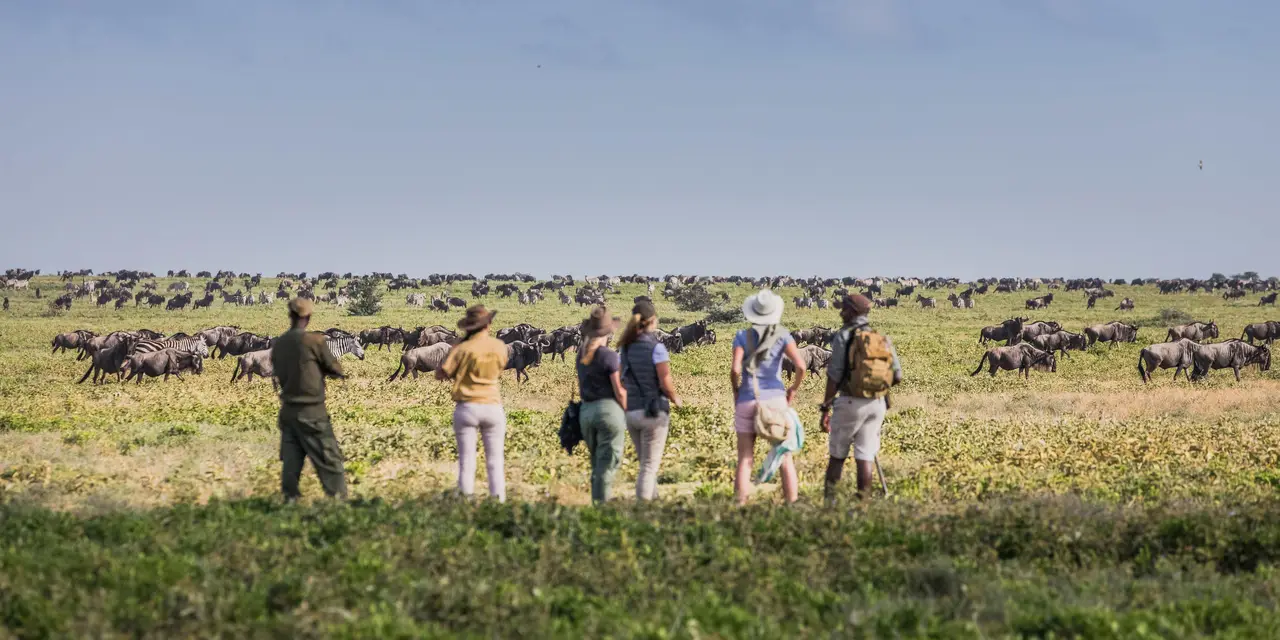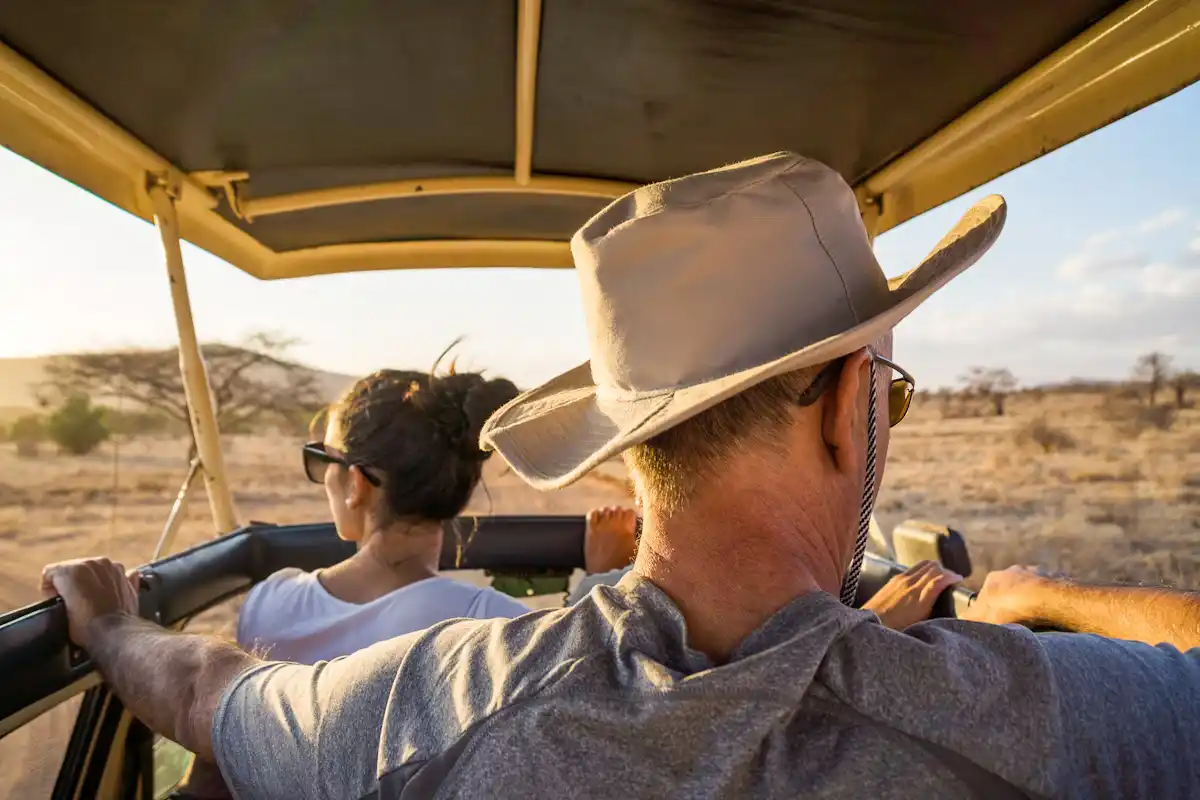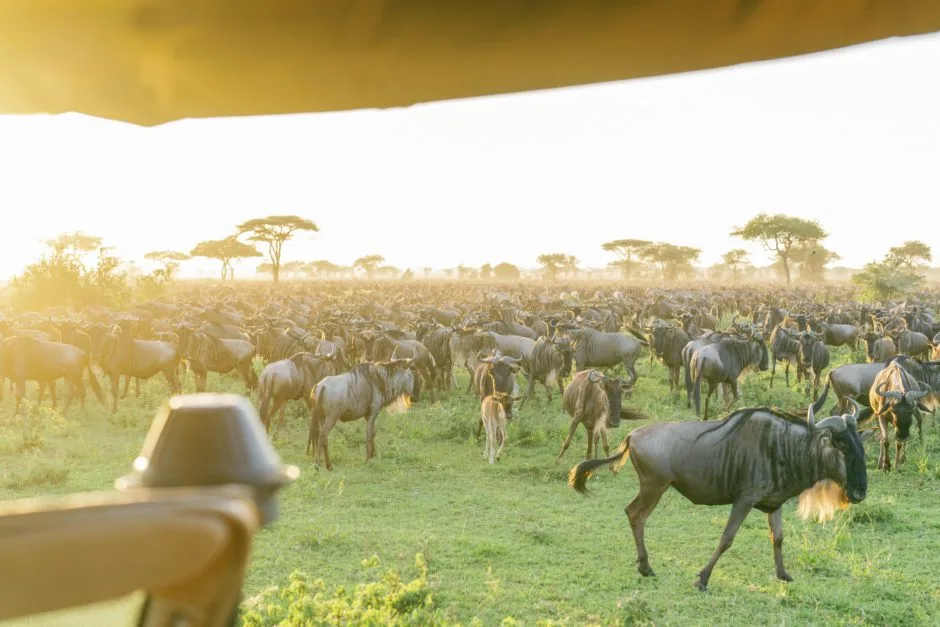Best Serengeti Safaris
Spanning an impressive 14,763km2 of undulating plains and isolated koppies (rocky hills), the Serengeti is Tanzania’s oldest, largest, and most iconic national park. Its vast golden savannah and endless grasslands are world-famous for hosting the awe-inspiring annual mammal migration, where over 2 million wildebeest, plains zebra, and gazelles make their way across the land – a truly unparalleled spectacle in Africa.
But the Serengeti offers more than just migration. Its plains are teeming with large populations of buffalo, elephants, hippos, giraffes, and antelopes. And where there’s abundant prey, the predators aren’t far behind. The park is a haven for lions, leopards, cheetahs, hyenas, and wild dogs, making it one of Africa’s premier safari destinations.
So, what are the best Serengeti safaris and tours, and how do you choose the perfect one for your adventure? Drawing from our extensive experience in safaris, we’ve curated a list of top Serengeti tours – all personally tested, customizable, and designed to match your travel dreams.
Best Serengeti Safaris & Holidays
Top Highlight of A Safari in Serengeti
Marvel at The endless plains
The Maasai people have a name for the Serengeti: ‘Siringet,’ meaning ‘the land that goes on forever.’ It’s a feeling that’s hard to truly understand—until you’re there.
Vast grasslands, dotted with flat-topped Acacia trees, give the Serengeti that classic “Out of Africa” feel. Alongside Kenya’s Maasai Mara, the Serengeti forms one of Africa’s (and the world’s?) most iconic landscapes. The Serengeti ecosystem is also one of the oldest and most scientifically significant on Earth.
Its weather, wildlife, and plant life are believed to have changed very little for as long as a million years or more, giving the area an incredible prehistoric presence. For many, the sight of Acacia trees spread across endless grasslands defines Africa, and when you add a Maasai warrior with his cattle to the scene, it’s as though the conversation ends there. This is Africa!
The Serengeti Sunset
Many people argue that the sunsets in Serengeti are among the most breathtaking on Earth. As the day draws to a close, the sky transforms into a stunning canvas of vibrant pinks, rich purples, and fiery oranges, all melting into each other before the sun slips below the horizon.
The beauty is intensified by the elements—sometimes, the dust stirred up by the massive wildebeest herds in migration swirls in the air, adding a soft, golden haze to the view.
On other occasions, the dark, looming rain clouds add a dramatic contrast to the colors, as if nature itself is putting on a show. The entire scene, with its ever-changing hues and the sounds of the African wilderness in the background, feels almost surreal. It’s a moment that seems to stop time, leaving you completely immersed in the raw beauty of the Serengeti. Truly magical!
The Big Five Animals
Serengeti is famous worldwide for its incredible wildlife, with a staggering variety of animals roaming its vast landscapes. This abundance can be attributed to the park’s diverse habitats, which range from lush riverine forests and marshy swamps to rocky kopjes, open grasslands, and dense woodlands. These varied environments provide a home to a wide array of species.
Packs of African Wild Dogs, Cheetahs, Jackals, and Spotted Hyenas—can often be seen trailing the massive herds of Wildebeest, Zebras, and Gazelles. The Serengeti also boasts an impressive array of grazers and predators, creating a dynamic and thriving ecosystem. From the comfort of your vehicle, you can spot Africa’s legendary Big Five: lions, elephants, rhinos, leopards, and buffalo.
Some animals, like the rare and endangered black rhino, can be hard to spot, and many creatures are more active during different parts of the day. To maximize your chances of seeing the full spectrum of wildlife, early morning and late afternoon game drives are a must, ensuring you witness the Serengeti in all its majestic glory.
Witness the Great Migration
The Great Migration is one of the most breathtaking natural phenomena in the world, a spectacle of wildlife that draws thousands of visitors to the Serengeti each year.
Between June and December, over 2 million wildebeests, zebras and gazelle, embark on an a journey across the Serengeti plains in search of water and fresh grazing grounds as the dry season takes hold. The migration is a dramatic display of raw power and survival, as the animals thunder across the wide-open grasslands, their hooves pounding the earth in a rhythmic roar.
En-route, they must navigate treacherous river crossings, where the waters are teeming with crocodiles waiting for a chance to strike. The sight of thousands of animals charging through the rivers, with the landscape stretching out endlessly around them, is nothing short of mesmerizing. It’s an unparalleled experience—one that you won’t find anywhere else in Africa. Witnessing this extraordinary event truly feels like stepping into the heart of nature’s most powerful rhythms.
Questions About Serengeti Safaris
When is the best time to see the Serengeti great migration?
The wildebeest migration in the Serengeti follows a largely predictable annual pattern, though it can vary from year to year, primarily due to rainfall. If you want to witness a vast, uninterrupted line of wildebeest moving, the Western Corridor is your best bet in June and July, when the migration heads toward the south bank of the Grumeti River and prepares to cross. For a more reliable sighting of river crossings, head to the far northern part of the park around September, when large herds consistently make the dangerous crossing of the Mara River.
From December to April, the wildebeest spread out across the southeastern Serengeti, which is easily accessible from Arusha, though you may still see massive herds stretching across the plains. This area also serves as the main calving grounds, with peak calving season occurring in January and February, drawing numerous predators to the region.
How can I avoid the crowds on a safari in Serengeti?
The Serengeti is a vast reserve that typically doesn’t suffer from the overcrowding seen in the much smaller Masai Mara National Reserve in Kenya. The only exception is around the Seronera area near the park headquarters, where popular sightings often attract a swarm of safari vehicles responding to radio reports from other guides. Additionally, vehicles tend to cluster in areas where the migration is currently happening.
To avoid the crowds, it’s best to minimize your time around Seronera and split your safari between two different areas: one in the heart of the migration and another in a less seasonal region (for example, the far north between November and June or the Western Corridor from August to October).
Keep in mind that April to May is the off-season in the Serengeti due to heavy rains, but it can still be a great time to visit. This period is less crowded, and the landscape is especially beautiful, with large herds of wildebeest typically found in the far south.
Also, roads around Seronera are busiest during peak wildlife-viewing hours—7:30 AM to 10 AM and 2 PM to 4:30 PM. To avoid the rush, skip breakfast at camp and head out early, as game drives start at 6 AM. You can enjoy the peaceful first light of day with a packed breakfast in hand.
How long is the drive to Serengeti?
The journey from Arusha to the park headquarters at Seronera covers about 300km/186mi. The first half of the drive follows a paved road that passes Lake Manyara and leads to the main eastern entrance of the Ngorongoro Conservation Area (NCA). The second half takes you along a rough, dusty, and bumpy track around the Ngorongoro Crater rim and the western plains of the NCA.
The trip usually takes at least six hours, but it’s better to allocate a full day. However, many Serengeti tours include overnight stops at Lake Manyara and/or Ngorongoro Crater, which makes the drive more manageable.
What condition are the roads in the Serengeti National Park?
By most international standards, the roads are in poor condition. While it’s not an issue during leisurely game drives, longer trips between lodges and camps can be challenging. If this seems daunting or you have a sensitive back, consider booking a Serengeti safari package that includes flights to and between the park, lodges, and camps.
What are the pros and cons of different Serengeti accommodation types?
There are several types of accommodation available for Serengeti safari tours, each with its own advantages and drawbacks. If you’re looking to save money, a basic camping safari with a budget operator is the most affordable option. These usually provide tents, sleeping bags, and simple meals, but the experience is quite no-frills.
For those seeking more comfort, there are ‘hotel in the bush’ lodges operated by chains like Serena and Sopa. These are typically mid-range in price and offer a high level of comfort, with facilities designed to provide a safe, enclosed environment at night, making them ideal for first-time safari-goers who may be anxious about wildlife encounters.
Additionally, there are numerous smaller lodges and tented camps, some permanent and others seasonal to follow the migration. These offer a mix of medium to high comfort levels, along with a more authentic bush experience. These camps often provide a high chance of wildlife sightings, especially at night. Generally, the smaller, more exclusive camps come with higher price tags, reflecting their luxury and privacy
Discover Your Next Adventure with

Contact a Expert Safari Expert
Our Trusted Partners







